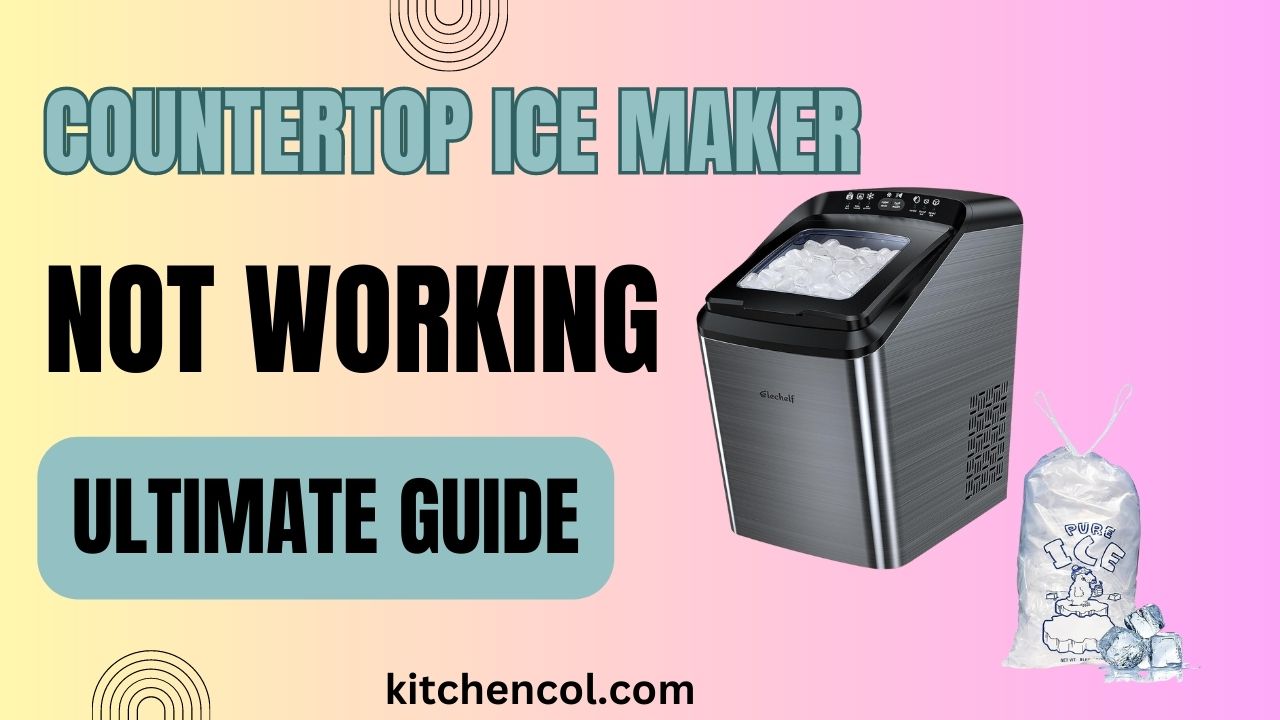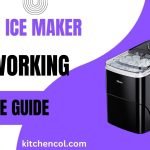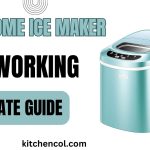Countertop ice makers have revolutionized the way we enjoy chilled beverages and entertain guests. These compact appliances offer a constant supply of ice at our fingertips, eliminating the need for traditional ice trays. However, encountering a malfunctioning countertop ice maker can quickly dampen the convenience it promises. In this troubleshooting guide, we will delve into common issues that can cause your countertop ice maker to stop working and explore step-by-step solutions to restore it to optimal functionality.
By mastering these troubleshooting techniques, you’ll be equipped to diagnose and potentially fix the problem without unnecessary expenses. Let’s dive in and reclaim the joy of a fully operational countertop ice maker.
Common Reasons for Countertop Ice Maker Malfunctions
Countertop ice makers are remarkable appliances that effortlessly provide a steady stream of ice, but like any technology, they can experience hiccups. Let’s explore some of the most frequent culprits behind countertop ice maker malfunctions and discover how to address them effectively.
A. Power Supply Issues:
Check the Power Cord and Outlet: Sometimes, the solution is as simple as making sure the power cord is securely plugged into a functioning outlet. A loose connection can disrupt the ice maker’s operation.
Resetting the Unit: If the ice maker seems unresponsive, try resetting it by unplugging it for a few minutes and then plugging it back in. This can often clear minor glitches and restore normal operation.

B. Water Supply Problems:
Ensure Proper Water Level: A low water level can prevent the ice maker from producing ice. Check that the water reservoir is adequately filled according to the manufacturer’s guidelines.
Unclog or Clean the Water Inlet: Mineral deposits or debris can clog the water inlet, obstructing the flow of water. Regularly cleaning this component can prevent such issues.
Verify Water Quality: Impurities in the water can affect ice quality. If your ice maker is producing cloudy or off-tasting ice, consider using filtered water to improve the end result.
C. Temperature and Environment:
Operating Within Recommended Temperature Range: Countertop ice makers function optimally within specific temperature ranges. Excessive heat or cold can impact their performance. Make sure the unit is placed in an environment that aligns with the manufacturer’s recommendations.
Proper Ventilation Around the Unit: Adequate airflow is crucial for efficient cooling. Ensure that the ice maker has sufficient space around it and is not placed near heat-emitting appliances.
Understanding these common reasons for countertop ice maker malfunctions is the first step in resolving issues and restoring your ice maker to its full potential. In the next section, we will walk you through a comprehensive troubleshooting process to help you identify and tackle specific problems with your appliance.
Step-by-Step Troubleshooting
Encountering a non-functioning countertop ice maker can be frustrating, but a systematic approach to troubleshooting can help you identify and resolve the issue with confidence. Follow these step-by-step instructions to pinpoint the problem and get your ice maker back on track.
A. No Ice Production:
Check Power and Reset the Unit:
- Verify that the power cord is firmly inserted into a working outlet.
- If the unit is unresponsive, unplug it for a few minutes, then plug it back in to reset any potential glitches.
Inspect Water Supply and Inlet:
- Verify that the water reservoir is adequately filled according to the manufacturer’s guidelines.
- Examine the water inlet for clogs or debris. Clean it if necessary to ensure proper water flow.
Confirm Proper Temperature Settings:
- Check the temperature settings of the ice maker. It should be within the recommended range for optimal ice production.
- Adjust the temperature settings if needed, allowing the unit to operate under ideal conditions.
B. Ice Quality Issues:
Small or Incomplete Cubes:
- Ensure the water supply is sufficient. A low water level can lead to smaller ice cubes.
- Clean the condenser coils, as dirty coils can impact cooling efficiency and ice formation.
Cloudy or Foul-Tasting Ice:
- Use filtered or bottled water to improve ice quality.
- Regularly clean the ice maker according to the manufacturer’s instructions to prevent the buildup of impurities.
C. Unusual Noises:
Rattling or Vibrating Sounds:
- Check if the ice maker is placed on a stable surface. Unstable placement can cause vibrations and noise.
- Make sure the unit is level. Adjust the feet if necessary to minimize vibrations.
Grinding or Scraping Noises:
- Examine the ice tray and mechanism for any obstructions or misalignments. Clear any debris that might be causing the noises.
By methodically working through these troubleshooting steps, you can often identify and resolve the issue causing your countertop ice maker to malfunction.
However, if you find that the problem persists despite your efforts, it may be time to consider seeking professional assistance or contacting customer support for further guidance.
In the next section, we will explore some DIY fixes and maintenance practices that can help keep your countertop ice maker in optimal condition.
DIY Fixes and Maintenance
Regular maintenance and proactive DIY fixes can significantly extend the lifespan of your countertop ice maker and keep it running smoothly. Here are some practical steps you can take to address common issues and ensure optimal performance.
A. Cleaning the Unit:
Regular Cleaning Routine:
- Follow the manufacturer’s guidelines for cleaning frequency. Regular cleaning prevents the buildup of mineral deposits and mold, which can affect ice quality.
- Before cleaning, switch off and disconnect the ice machine.
Removing Mineral Deposits:
- Use a mixture of vinegar and water to descale the interior components. Allow the solution to sit for a while before rinsing thoroughly with clean water.
B. Checking Components:
Inspecting the Condenser Coils:
- Over time, dust and debris can accumulate on the condenser coils, reducing cooling efficiency. Gently vacuum or brush the coils to keep them clean.
Verifying the Ice Tray Mechanism:
- Examine the ice tray and the mechanism that moves it. Ensure there are no obstructions, ice jams, or misalignments that could hinder proper ice production.
C. Filter Replacement:
Importance of Clean Water:
- If your ice maker has a water filter, follow the manufacturer’s guidelines for replacement. A clean filter ensures better water quality and ice taste.
Steps to Replace or Clean the Filter:
- Refer to the user manual for instructions on replacing or cleaning the water filter. This simple step can significantly improve ice quality.
Remember, proper maintenance not only addresses existing issues but also prevents potential problems from arising. Incorporating these DIY fixes and maintenance practices into your routine can save you time and money in the long run.
In the next section, we will discuss situations where professional help might be necessary and provide guidance on when to reach out to experts for assistance in resolving complex countertop ice maker malfunctions.
When to Seek Professional Help
While many countertop ice maker issues can be resolved through DIY fixes and troubleshooting, there are situations where seeking professional assistance is the wisest course of action. When to think about consulting professionals are the following:
A. Beyond DIY Troubleshooting:
- If you’ve followed the troubleshooting steps diligently and the issue persists, it may indicate a more complex problem that requires specialized knowledge and tools.
B. Potential Internal Malfunctions:
- Any internal components or electrical issues that you are not equipped to handle should be addressed by a trained technician to avoid further damage or safety hazards.
C. Contacting Customer Support or a Technician:
- If your ice maker is still under warranty, it’s advisable to contact the manufacturer’s customer support for guidance or to schedule a repair.
- If the warranty has expired or you prefer professional assistance, consider hiring a certified appliance repair technician experienced in ice maker repairs.
D. Unusual Noises or Odors:
- If your ice maker is emitting unusual odors or persistently making loud and unfamiliar noises, it’s a sign that a professional inspection is needed.
E. Water Leakage:
- Water leakage from the ice maker can cause damage to your countertop or surrounding areas. A technician can diagnose the source of the leakage and address it effectively.
F. Complex Electrical Issues:
- Any problems related to the electrical components of the ice maker should be handled by a professional to ensure safety and prevent electrical hazards.
Remember, attempting complex repairs without the necessary expertise can lead to further complications and safety risks. Seeking professional help when needed ensures that your countertop ice maker is repaired correctly and safely, restoring it to optimal working condition.
In the final section, we’ll explore preventive measures you can take to maintain the efficiency and convenience of your countertop ice maker over the long term.
Preventive Measures
Maintaining the efficiency and reliability of your countertop ice maker requires proactive care and attention. By incorporating these preventive measures into your routine, you can enjoy uninterrupted ice production and prolong the lifespan of your appliance.
A. Regular Maintenance Schedule:
Follow Manufacturer’s Guidelines: Adhere to the maintenance recommendations provided in the user manual. This includes cleaning frequency, filter replacement, and any specific care instructions.
Scheduled Cleanings: Establish a routine for cleaning the ice maker’s interior components, water reservoir, and ice tray. Regular cleanings prevent mineral buildup and ensure hygienic ice production.
B. Water Quality Considerations:
Use Filtered Water: Using filtered or bottled water helps improve ice quality and prevents mineral deposits from affecting the appliance’s performance.
Monitor Water Supply: Check the water reservoir periodically to ensure it’s adequately filled. Low water levels can lead to insufficient ice production.
C. Proper Placement and Usage Guidelines:
Ventilation: Ensure the ice maker has proper ventilation space around it to prevent overheating. Avoid placing it near heat-emitting appliances.
Level Surface: Place the ice maker on a stable and level surface to minimize vibrations and noise.
Temperature Control: Keep the ice maker within the recommended operating temperature range. Extreme temperatures can hinder ice production.
D. Timely Repairs and Professional Servicing:
Address Issues Promptly: If you notice any unusual sounds, odors, or performance issues, address them promptly to prevent further complications.
Professional Maintenance: Schedule periodic professional maintenance, especially for complex tasks such as checking electrical components and internal mechanisms.
E. Educate Users:
Proper Usage: If you share the ice maker with others, ensure everyone is aware of its proper usage, cleaning procedures, and any specific guidelines.
Children Safety: Educate children about the appliance’s operation and potential hazards, especially if it’s located in an accessible area.
By integrating these preventive measures into your routine, you’ll be able to enjoy a consistently reliable countertop ice maker that serves you well over time. Regular care and attention not only enhance ice production but also contribute to a hygienic and enjoyable ice-making experience.
Also Read: VIVOHOME Ice Maker Not Working-Step BY Step Guide
Conclusion
In the world of modern convenience, a countertop ice maker stands as a symbol of hassle-free refreshment. This compact appliance has the power to transform ordinary moments into delightful ones, whether it’s a chilled drink on a hot day or hosting friends with perfectly chilled beverages.
As we’ve explored in this guide, encountering a non-functional countertop ice maker doesn’t have to be a daunting experience. By understanding the common reasons for malfunctions, mastering step-by-step troubleshooting, and embracing DIY fixes and maintenance, you gain the ability to revive your ice maker and restore its magic.
Remember, while DIY solutions can work wonders, there are instances where seeking professional help is the wisest choice. Ensuring timely repairs and adhering to preventive measures will keep your ice maker humming along for years to come.
In the end, maintaining a well-functioning countertop ice maker is not just about preserving an appliance—it’s about preserving the joy of effortless refreshment, the delight of sharing cold beverages with loved ones, and the satisfaction of having one less thing to worry about in your daily life. So, here’s to a perfectly chilled glass and the simple pleasure of ice on demand.

My name is Manan Bukhari and I am an expert in reviewing kitchen products for years. I have a passion for testing multiple gadgets especially related to home & kitchen. I love to spend my free time in resolving issues if I face some in any of my daily use things. I have fixed multiple gadgets of my home on my own without any assistance and that thing gave me confidence to make a blog on troubleshooting of items that are for daily use to assist you folks. Even my wife praises me for having such talent. I always explore new machines on my own because this thing fascinates me.



